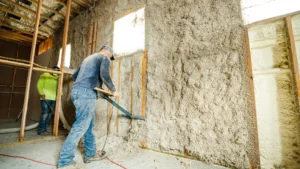Cellulose insulation is a widely used material for improving energy efficiency in homes and buildings. Made primarily from recycled paper products treated with fire-retardant chemicals, it provides excellent thermal performance and soundproofing. Homeowners in Panhandle, TX, can benefit from its ability to regulate indoor temperatures, especially given the region’s fluctuating weather conditions.
Advantages of Cellulose Insulation for Panhandle, TX
Energy Efficiency
Cellulose insulation minimizes heat transfer, helping to reduce energy bills. It forms a dense barrier that slows air movement, preventing conditioned air from escaping and reducing the workload on HVAC systems.
Environmental Benefits
Since cellulose insulation consists largely of recycled materials, it contributes to waste reduction. The treatment process uses non-toxic additives, making it a safer and more sustainable choice compared to some alternatives.
Fire Resistance and Soundproofing
The fire-retardant treatment applied to cellulose insulation enhances its resistance to combustion. Additionally, its density helps absorb sound, making it an effective solution for noise control between walls.
Preparing for Installation
Assessing Wall Structure
Before installation, examine the wall cavities to determine the best approach. Whether working with new construction or retrofitting an existing home, different techniques may be necessary to ensure proper coverage and efficiency.
Selecting the Right Application Method
There are two primary methods for installing cellulose wall insulation:
- Dry Blown-In Insulation: Ideal for existing walls, requiring small access holes to be drilled for filling cavities.
- Damp-Spray Insulation: Suitable for new construction, where the material is mixed with a small amount of water to help it adhere to surfaces.
Ensuring Proper Ventilation
Proper ventilation in attics and wall spaces is essential to prevent moisture buildup. Installing vapor barriers or house wraps can further protect against potential condensation issues.
Installation Process
Step 1: Preparing the Work Area
- Clear any obstructions from the walls.
- Seal major air leaks around windows, doors, and electrical outlets before adding insulation.
- Use protective gear such as masks and goggles when handling insulation material.
Step 2: Creating Access Points
For retrofit applications, small holes are drilled at the top of the wall cavity. These allow for the insertion of the blower hose used to distribute the insulation.
Step 3: Blowing in the Insulation
Using a high-powered insulation blower, the cellulose material is injected into the wall cavities. The key is to ensure even distribution without creating voids or compressed areas that could affect performance.
Step 4: Sealing the Access Holes
Once the insulation is in place, the drilled holes are sealed using patches or plugs that match the wall surface. For new construction, a smooth finish is applied before drywall installation.
Maintaining Cellulose Insulation
Checking for Settling
Over time, cellulose insulation may settle slightly. Conduct periodic inspections, especially in older homes, to determine if additional material is needed.
Monitoring for Moisture Issues
If moisture seeps into the insulation, it can lead to mold growth or reduced effectiveness. Ensuring that walls are properly sealed and ventilated helps prevent such issues.
Professional Installation Services in Panhandle, TX
For optimal results, working with experienced professionals can ensure a seamless installation process. Flatland Roofing & Insulation offers expert cellulose insulation services tailored to the specific needs of homes in Panhandle, TX. Our team is equipped with the latest tools and techniques to enhance energy efficiency and comfort.
Cost Considerations
Factors Influencing Cost
- Wall Size and Thickness: Larger areas require more material and labor.
- Existing Wall Condition: Older walls may need additional preparation work.
- Labor and Equipment: Professional installation includes the cost of specialized machinery and expertise.
Long-Term Savings
Investing in cellulose insulation leads to significant reductions in heating and cooling costs. Many homeowners see a return on investment within a few years due to lower energy consumption.
Common Challenges and Solutions
Uneven Distribution
Proper training and equipment help prevent voids or excessive compaction, ensuring that insulation is evenly spread throughout the wall cavities.
Addressing Existing Insulation
For homes with outdated or deteriorating insulation, removing old material before adding cellulose can improve overall effectiveness.
FAQs
How long does cellulose wall insulation last?
Cellulose insulation can last 20–30 years with proper installation and maintenance.
Is cellulose insulation safe for homes?
Yes, it is treated with fire retardants and does not contain harmful chemicals.
Can cellulose insulation be installed over existing insulation?
In some cases, it can be added over old insulation, but a professional assessment is recommended to determine feasibility.
Does cellulose insulation attract pests?
No, the chemical treatment in cellulose insulation helps deter pests and rodents.
How does cellulose compare to fiberglass insulation?
Cellulose provides better air-sealing properties and is made from recycled materials, making it a more eco-friendly option.
What are the signs that my home needs more insulation?
Higher energy bills, uneven temperatures, and drafts indicate insufficient insulation.
Is cellulose insulation resistant to mold?
It has some resistance due to its treatment, but moisture control measures should still be in place to prevent mold growth.
How much does cellulose wall insulation cost?
Costs vary based on the size of the area, wall condition, and installation method. Contact Flatland Roofing & Insulation for a detailed estimate.
Can I install cellulose insulation myself?
While DIY installation is possible, professional installation ensures better coverage, efficiency, and compliance with building codes.
Who should I contact for cellulose insulation in Panhandle, TX?
Flatland Roofing & Insulation provides expert installation services. Call (806) 606-6794 or email info@flatlandroofcoatings.com for a consultation.




